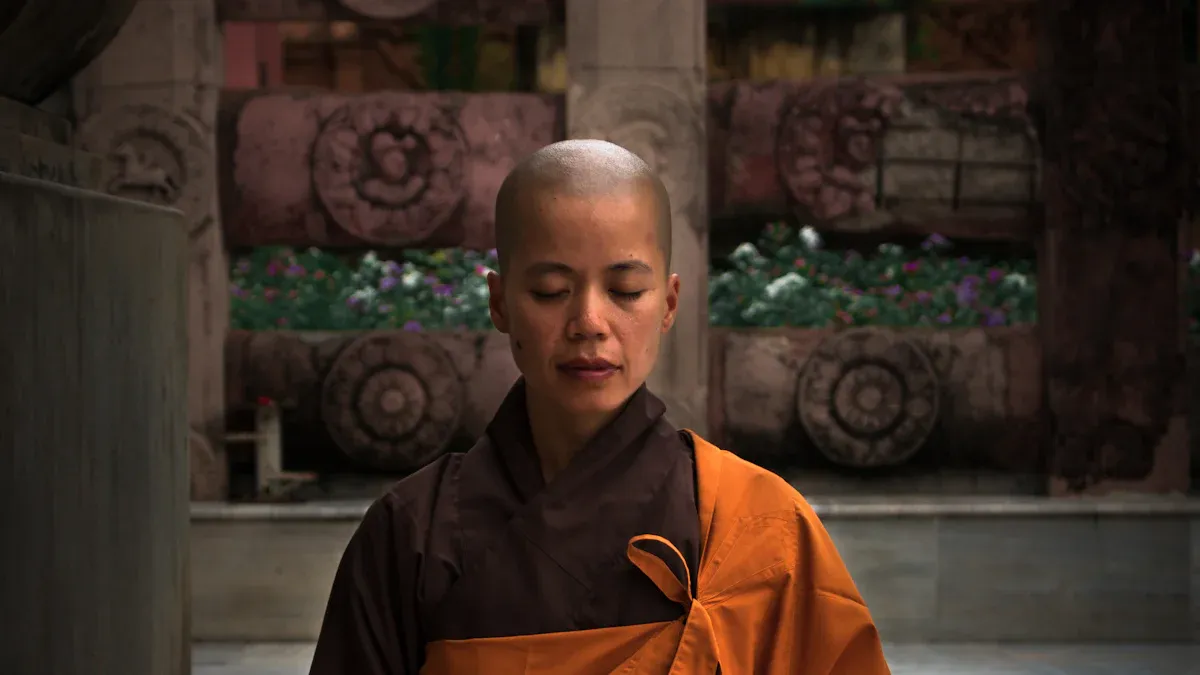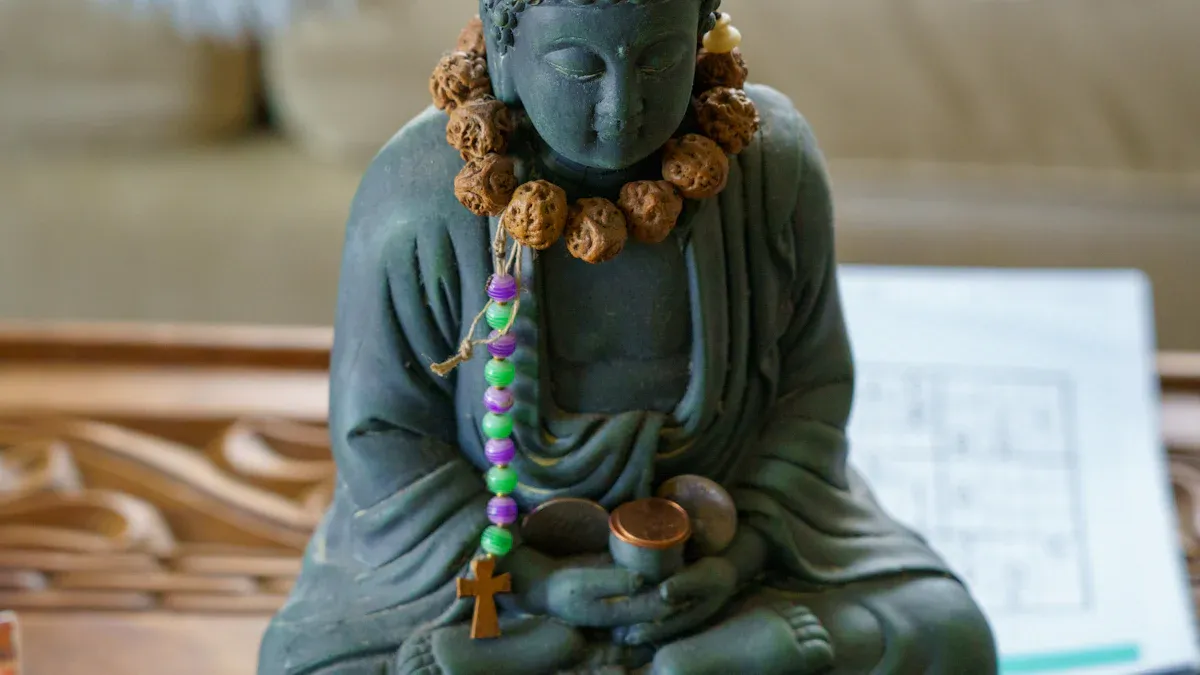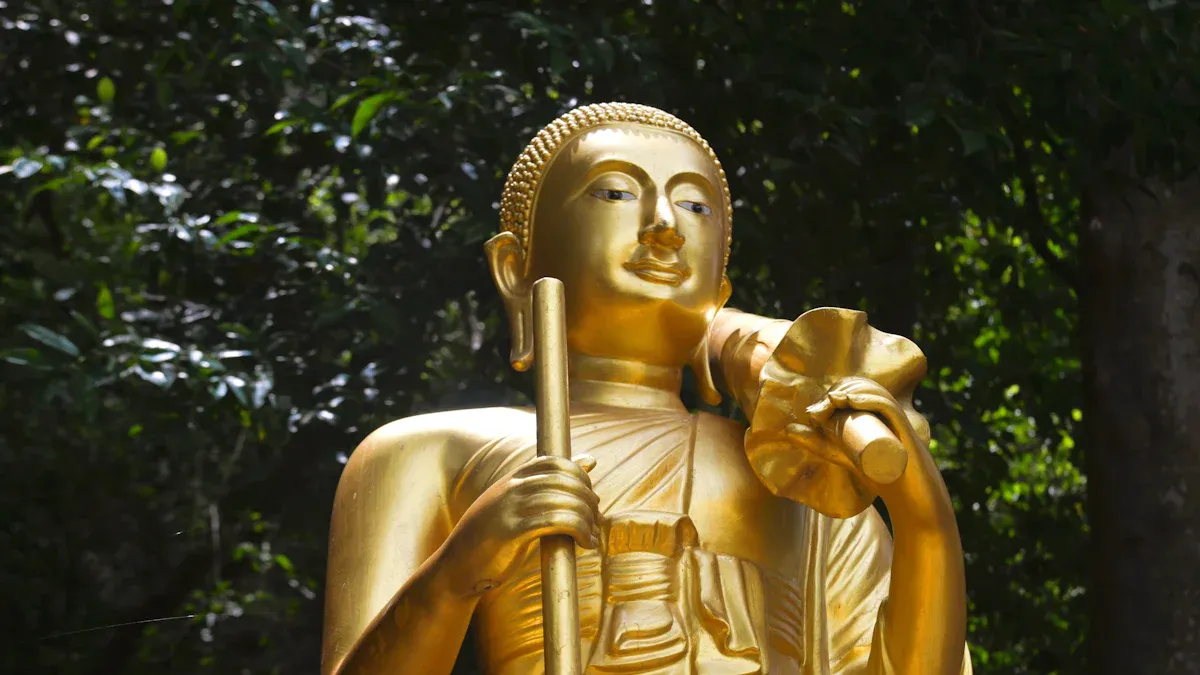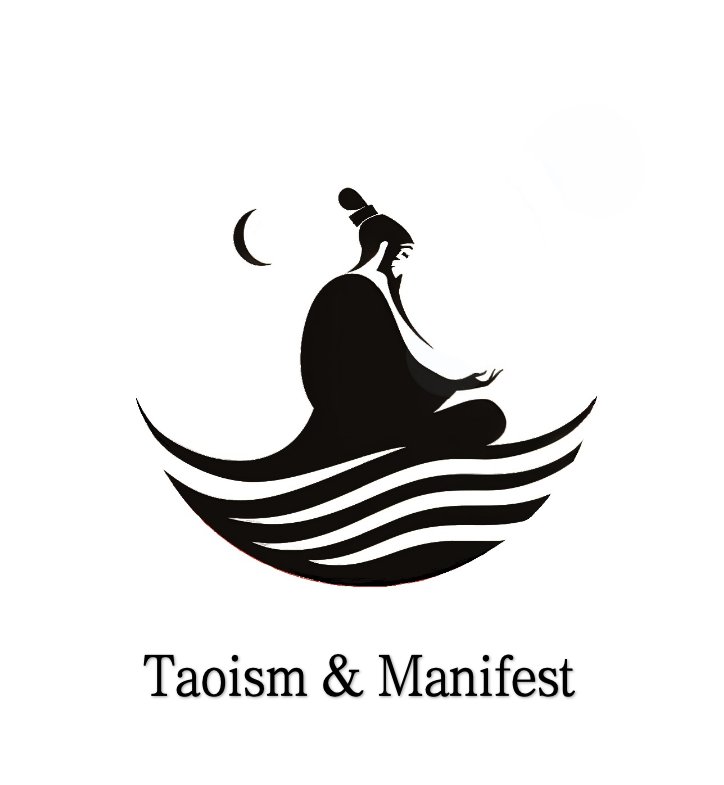
Many people want to feel calm and balanced in their busy lives. They might try different meditation styles to help them stay focused. Taoism and Buddhist meditation both give special ways to practice mindfulness. The 2012 National Health Interview Survey showed that many adults in the United States use different meditation methods together. They often mix mindfulness with other practices. This mix can help people find more awareness and peace in a gentle way.
Key Takeaways
Taoist and Buddhist meditation both help people feel calm. They teach people to focus and feel balanced. These practices show how to be mindful and peaceful. Taoism teaches people to move with nature and energy. Buddhism teaches people to train their minds and be kind. Mixing Taoist gentle energy work with Buddhist mindfulness is helpful. It makes a strong and simple meditation practice. Meditating every day, even for a short time, helps your mind. It also helps you feel balanced and make better choices. If you start simple and practice often, you can enjoy these meditation styles.
Complementary Practices
Shared Goals
Taoist and Buddhist meditation both help people feel calm inside. These practices help people notice what is happening right now. People who do these meditations often feel closer to themselves and others. Both ways teach mindfulness, peace, and understanding. They say real happiness comes from knowing your mind and living in balance with something bigger. Taoist meditation helps people match the natural flow of the world and balance things like Yin and Yang. Buddhist meditation helps people get wise and stop suffering by watching thoughts and feelings without getting stuck in them. When used together, these meditations help people live a calm and balanced life.
Tip: Doing mindfulness every day, even for a short time, can help anyone feel more calm and focused.
Key Differences
Taoism and Buddhism want similar things, but their ways are not the same. Buddhist meditation uses clear steps to learn about the mind and reach enlightenment. It teaches that things always change and the self is not fixed. Taoist meditation cares more about being in tune with nature and the flow of chi. People use breathing, gentle moves, and pictures in their minds to balance body and mind. Taoist ideas like Wu Wei, or acting without trying too hard, tell people to act in a natural way. Buddhist meditation is more about learning with the mind, but Taoist meditation mixes energy work and movement with meditation. Both help people be more mindful and present every day.
Taoism in Meditation

Wu Wei
Wu Wei is a main idea in Taoism. It means to act without forcing things. People who use Wu Wei try to go with the flow of life. They do not fight against what happens. They do not try to control everything. Instead, they let things happen and stay calm. They answer problems with peace and patience.
"If your body is not straight,
You will not feel strong inside.
If you are not calm,
Your mind will not be clear."
This old teaching says people find order when they relax. Wu Wei started as a simple idea in Taoism. Now, it is a way to handle stress and make good choices. People today use slow breathing, easy movements, and quiet time to practice Wu Wei every day.
Energy Cultivation
Energy cultivation is also important in Taoist meditation. People focus on their breath and how they stand. This helps their chi move well in the body. Some people stand still in poses like Zhan Zhuang. Others move slowly. Many say these habits give them more energy and help them think better. They also say it helps with pain. Some studies show these moves help blood flow, sleep, and health. Science does not prove chi is real. Still, many people like these peaceful habits.
Nature Connection
Taoist meditation helps people feel close to nature. People often meditate outside. They listen to birds or watch water move. This helps them feel calm and balanced. Being in nature helps them let go of stress. They find joy in simple things. Taoism says living with nature brings wisdom and happiness. Many people feel this helps them heal and worry less. It also helps them feel better in life.
Buddhist Meditation

Mindfulness
Buddhist meditation is about mindfulness. Mindfulness means paying attention to right now. People learn to notice thoughts and feelings. They do not judge what they notice. This helps people understand their minds better. They start to see things as they really are. Many Buddhist groups teach mindfulness with easy steps. They might focus on breathing or watch their bodies. Some important ideas are:
Mindfulness is part of the Noble Eightfold Path. This path helps people live wisely and kindly.
Techniques like anapanasati and the Four Foundations of Mindfulness build awareness.
Mindfulness works with right intention and right effort. These help keep the mind healthy and balanced.
People who practice mindfulness feel calmer and more focused. They learn to handle problems with patience and clear thinking.
Concentration
Concentration, called samadhi, is also important in Buddhist meditation. It means training the mind to focus on one thing. People often use the breath, a candle, or a sound to focus. This practice makes the mind stronger over time. Studies show advanced meditators can focus for a long time. Their brains work harder in areas for attention and self-control. Even new learners notice better focus and memory after a few weeks. Concentration helps people stay steady and clear when life is busy.
Tip: Try to focus on your breath for a few minutes each day. Notice how your mind feels before and after.
Compassion
Compassion is a key value in Buddhist meditation. People use loving-kindness meditation to grow care for themselves and others. Compassion means seeing suffering and wanting to help. People learn to be kind to themselves. They also see that everyone has hard times. Programs like Compassion Cultivation Training use guided meditations and group work to teach these skills. Studies show compassion meditation helps mental health and balance. It also builds self-awareness. Practicing compassion helps people feel more connected. It brings joy to everyday life.
Integration Methods
Blended Techniques
Many experts say to mix Taoist and Buddhist meditation. They tell people to find a quiet place or go outside. This helps the mind feel calm. People often start by thinking about what they want from meditation. In Taoism, this means going with the flow of life. In Buddhism, it means focusing on being kind and aware. Both use silence or simple rituals before starting to get ready.
A mixed meditation can use Taoist ideas like picturing soft light moving in the body. It can also use Buddhist breath awareness and mindfulness. People often let thoughts come and go, like in Taoism. At the same time, they try to stay focused on now, like in Buddhism. This mix helps people feel calm but also awake.
Tip: Try meditating outside or in a cozy room. Let nature or a peaceful space help you relax.
Step-by-Step Practice
A simple way to use both Taoist and Buddhist ideas can look like this:
Prepare the Space
Pick a quiet place. Sit on a chair or cushion. Keep your back straight and relaxed.Set an Intention
Think about what you want from this time. You might want to feel calm, clear, or kind.Begin with Breath Awareness
Close your eyes softly. Notice your breath going in and out. Pay attention to how the air feels as you breathe.Visualize Energy Flow
Picture a warm light in your body’s center. With each breath, see the light move through your arms, legs, and head. This step uses Taoist energy work.Practice Mindfulness
Notice any thoughts or feelings that come up. Do not judge them. Let them pass by, like clouds in the sky. This step uses Buddhist mindfulness.Connect with Nature
If you are outside, listen to the sounds around you. If you are inside, imagine sitting by a stream or under a tree.Close with Compassion
Before you finish, wish yourself and others well. Feel thankful for your practice time.
This routine mixes Taoist gentle flow with Buddhist clear focus. Old books like The Secret of the Golden Flower and the Xishengjing talk about mixing these ways too.
Daily Application
People who use both kinds of meditation often make it a daily habit. Experts say to start with short times, like 10 to 15 minutes each day. Later, some people do 30 or 45 minutes. Many also use mindfulness during things like eating, walking, or talking.
Some people join groups to get help, especially at first. Others set reminders or make a special spot at home for meditation. People say they feel less stress, more patience, and better focus. They also notice better friendships and know themselves more. These good things grow as they keep practicing every day.
Note: Breath awareness is still the most used and helpful way for many. It helps keep the mind and body in the present.
By mixing Taoist and Buddhist ways, people can have a practice that feels easy and organized. This helps people grow and live more mindfully for a long time.
Benefits of Integration
Mental Clarity
When people use both Taoist and Buddhist meditation, their minds feel clearer. They learn to focus on what is happening right now. This helps them let go of things that distract them. It becomes easier to solve problems and make good choices. Many people see their thoughts are not as mixed up. They can notice what is most important. Doing this often helps the brain stay calm but also awake. This calm and alert feeling helps people remember things and learn better.
Tip: When your mind is clear, you can make better choices and feel less stress, even when life is busy.
Emotional Balance
People who use both kinds of meditation feel more steady inside. These ways teach them to see their feelings without getting lost in them. Some programs use both styles to help people talk about their feelings safely. Mindfulness and compassion are big parts of these meditations. They help people deal with stress and changes in life. Studies show compassion meditation can help people feel kinder and trust more. It can also lower stress chemicals in the body. Taoist meditation helps the body and mind relax together. This makes it easier to feel steady and calm. Over time, people become more patient and strong.
Behavioral Change
Using both kinds of meditation helps people change how they act every day. People who meditate this way often feel happier and more thankful. They treat themselves and others with more kindness. Research shows these habits can help people get along better and face hard times. Mindfulness and compassion help people make better choices and have more self-control. People see they do not react as much to stress. They make choices that fit what they care about. These changes help people build a happy and meaningful life.
Overcoming Challenges
Philosophical Differences
Some people think Taoist and Buddhist meditation cannot mix. They seem very different at first. Taoism often looks at harmony with nature and energy flow. Buddhism teaches letting go of cravings and seeing things clearly. Many believe Taoist meditation is just for the body. Others think Buddhist meditation is only for the mind. This is not true at all. Taoist meditation also helps the mind relax and let go. Buddhist meditation helps the body by teaching calmness and kindness. Both traditions care about surrender, acceptance, and healing. When people learn these ideas, they see both meditations can help each other.
Note: Taoist "Wu Wei" does not mean doing nothing. It means acting with ease and not forcing, which matches Buddhist ideas of non-striving.
Finding Balance
People sometimes feel unsure about mixing these practices. They may worry about making mistakes. Simple tips can help anyone find balance:
Sit in a relaxed way and breathe naturally.
Mix Taoist spontaneity with Buddhist mindfulness.
Notice distractions and gently bring focus back.
Change your practice for the weather or season.
Add meditation to daily life, like mindful walking or gratitude.
Let Taoist flow and Buddhist insight work together.
These steps help people make a practice that feels right for them.
Staying Consistent
It can be hard to keep a steady meditation habit. Many people stay motivated by linking meditation to values like kindness. In some traditions, meditation is part of a bigger plan for good living. Getting ready, like sitting up straight, eating healthy, and keeping a clean space, helps regular practice. Some traditions suggest routines with breath control and ethical living. When people see meditation as a way to grow mind and body, they want to keep going. Over time, these small steps lead to lasting change and a happier life.
Bringing Taoist and Buddhist meditation together gives many good things. People think more clearly and feel more balanced inside. They also learn more about who they are. They can try different ways and see what works best for them.
Meditation links the body, mind, and spirit.
Compassion and mindfulness help people heal and grow.
To begin, pick a time each day to practice. Make a quiet and calm place for yourself. Use easy breathing or gentle movements. Each part helps you keep learning about yourself and find happiness in daily life.
FAQ
What is the main goal of combining Taoist and Buddhist meditation?
The main goal is to help people feel calm and balanced. This mix lets people use both mindfulness and gentle energy work. They can find peace and focus in daily life.
Can beginners try both meditation styles together?
Yes, beginners can start with both. They can use simple breath awareness and gentle movements. Many people find it easy to blend these practices. Starting slow helps build a steady habit.
How long should someone meditate each day?
Most people start with 10 to 15 minutes. They can add more time as they feel comfortable. Short, daily practice works better than long, rare sessions.
Do I need special tools or a teacher?
People do not need special tools. A quiet space and a comfortable seat work well. Some people join groups or follow online guides. A teacher can help, but self-practice is also good.
What if my mind keeps wandering during meditation?
Everyone’s mind wanders sometimes. Gently bring attention back to the breath or body. Over time, focus gets stronger. Patience and kindness help the most.






